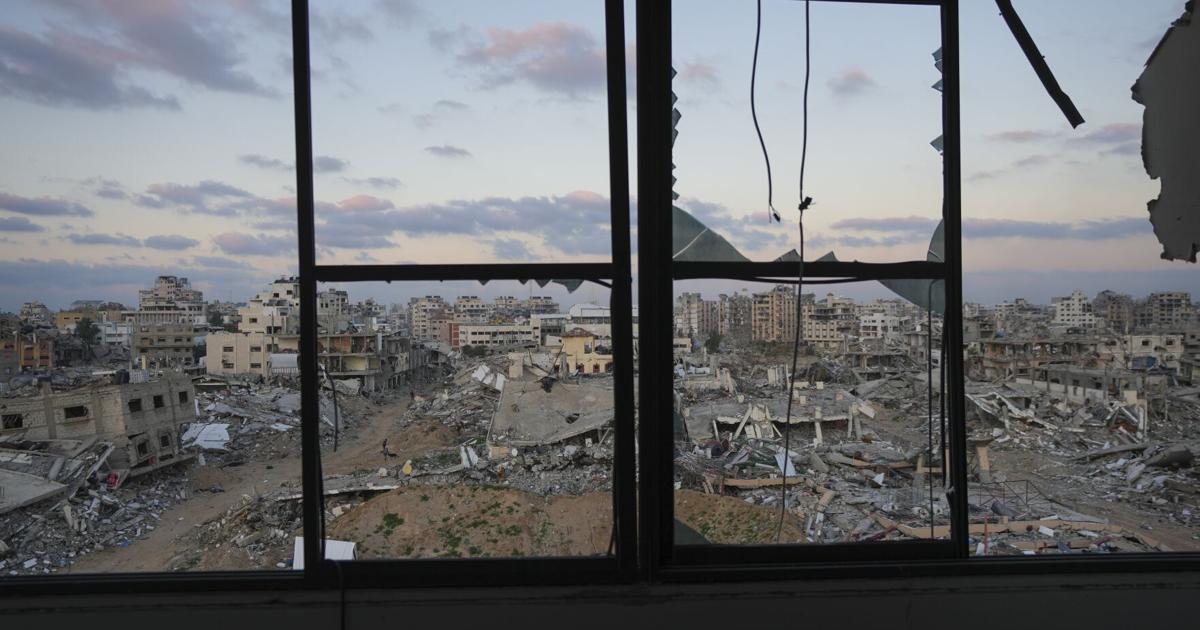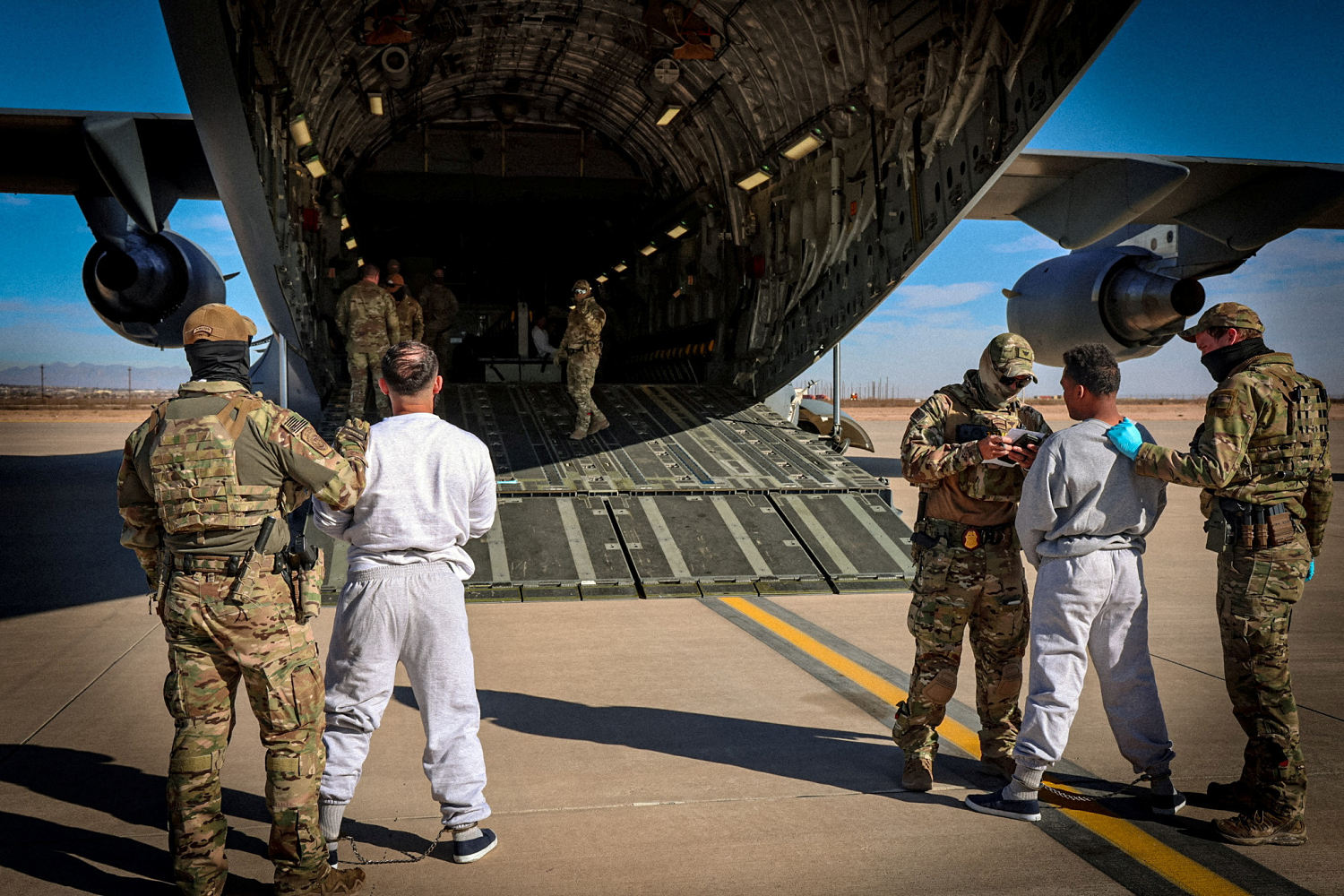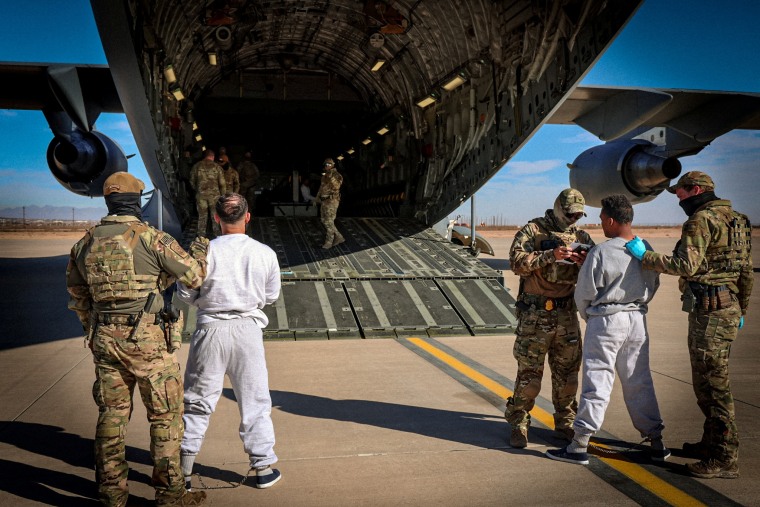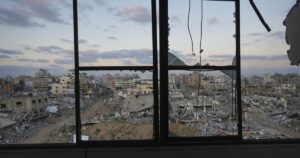The Dictatorship
Trump has assembled a mass deportation dream team

President-elect Donald Trump has been busy all week rolling out the members of his incoming administration. There are three names that stand out for how effective his choices are likely to be in their mission: South Dakota Gov. Kristi Noem for secretary of homeland security, former Immigration and Customs Enforcement head Tom Homan for “border czar” and top Trump adviser Stephen Miller for White House deputy chief of staff for policy and homeland security adviser.
Even as the rest of the administration may bumble about and clash with one another, that might not be the case when it comes to enforcing Trump’s dark immigration plan. Miller, Homan and Noem have the potential to be distressingly effective at working together. The only limit they will likely face is how much the public will allow to be carried out in its name.
Miller, Homan and Noem have the potential to be distressingly effective at working together.
In his new dual role, Miller will set the overall contours of American immigration policy. Homan will likely be charged with figuring out the operational details of Miller’s plans. And Noem will be tasked with implementing those policies and carrying out Trump’s promised deportation of an estimated 11 million undocumented immigrants.
One of the few holdovers from the early Trump days, Miller was a speechwriter and senior counselor under Trump in his first term. By the end of Trump’s term, he held tremendous sway over immigration policy and had helped purge the ranks of officials he deemed not aggressive enough in deterring border crossings. He helped shape many of the harshest immigration policies Trump implemented, including the so-called Muslim travel ban and the use of Title 42 to shut down the border entirely.
His main skill has always been taking Trump’s worst impulses about immigrants and making them almost palpable for moderate listeners. But given a title to match his ambitions and a direct line to Trump, he’ll have little to prevent him from being as extreme as he’d always hoped. Among the plans that Miller is spearheading are mass deportation camps to hold those collected in ICE workplace sweeps while being processed for expulsion and reinstating Title 42 at the border.
Aside from cracking down on undocumented immigrants, he has his sights on limiting immigration, as well. Miller has supported an end to birthright citizenship and pledged to “turbocharge” his efforts to strip naturalized citizens of their legal status. He has also prepared to end parole programs for migrants from Cuba, Haiti, Venezuela and Nicaragua and let Temporary Protected Status protections expire for more than 800,000 people.
While Miller forms the plans, it will likely be Homan working to coordinate carrying them out. Trump has indicated he’d like to see the military take part in the forced removal plans, which would require Pentagon buy-in and a likely transfer of money from defense programs to pay for a surge in detention facilities. There will be legal challenges that the Justice Department will have to defend against. Homan would be the point person making sure everyone is staying on the same page.
It’s worth noting that Homan’s job, such as it is, exists only as two words on paper right now, as there is no “border czar” job title in the federal system and no pool of resources for him to tap. It’s also fun to remember that he was promised, but never granted, a similar role in the first Trump administration. But Homan has the experience needed to carry out Miller’s wishes. He was hired to head ICE’s deportation arm before eventually becoming its director and implemented Trump’s “zero tolerance” child separation policy.
Immigration policy will be entirely top down with Noem in place, passing from Miller to Homan Noem’s orders to ICE and Customs and Border Patrol to carry them out
Meanwhile, Noem’s ascension is testament to how much all politics is national now. Leading South Dakota has given her little contact with the immigration system. According to the Migration Policy Instituteas of 2022 only 3.5% of the state’s population was foreign-born, far less than many parts of the country. But Noem has been extremely vocal about the supposed “invasion” taking place at the southern border, enthusiastically embracing Trump’s narrative and pulling stunts like deploying National Guard members to the Texas-Mexico border.
She would also be the only one of the three with any legal authority to carry out these deportation plans — or the money from Congress to do so. Immigration policy will be entirely top down with Noem in place, passing from Miller to Homan to Noem’s orders to ICE and Customs and Border Patrol to carry them out. It doesn’t matter if she herself doesn’t have any policy experience, not so long as she’s willing to be a figurehead for the White House and Senate Republicans are willing to confirm her.
There are still logistical problems that would have to be overcome should Miller’s deportation plan come to fruition. Homan said this week that he’d double the ICE presence in sanctuary cities like New York if needed, but ICE is already finding itself shorthanded. There’s also a shortage of immigration judges, whose courts face a massive backlog of cases. But that all supposes that there’s any interest from the administration in being efficient or precise in the process of forcibly removing millions from their homes.
Let’s not forget that the family separation policy was a humanitarian disaster. The conditions that families were held in were terrible, surpassed in the lack of care shown only by the failure of recordkeeping by the administration. DHS said in a report this year that there are still 1,360 children “without confirmed reunifications” with their families. We could call it incompetent if the goal had been to provide humane shelter for migrants being detained or speed their processing through the immigration system. But that wasn’t the goal. The goal was to make other migrants too afraid to cross the border.
Similarly, in this case, the goal isn’t to be efficient or precise. Miller is likely unconcerned about how long people might have to wait in hastily built camps before being deported. The odds seem high that there will be citizens who are rounded up and forced to prove their right to stay in the country. Homan has suggested avoiding family separations by deporting whole familiesproblematically hinting that children born in America would be illegally expelled, as well.
There is no way to carry out the kind of operation that Miller and his associates have in mind ethically or humanely — and so they won’t try to do so. In practice it will more likely be a deliberately cruel assault on human rights and dignity. But mass deportation doesn’t have to be done well to make Trump’s vision a reality. It just needs to be done.
Hayes Brown is a writer and editor for BLN Daily, where he helps frame the news of the day for readers. He was previously at BuzzFeed News and holds a degree in international relations from Michigan State University.
The Dictatorship
Trump’s suggestion the US ‘take over’ the Gaza Strip is rejected by allies and adversaries alike

DUBAI, United Arab Emirates (AP) — President Donald Trump’s proposal that the United States “take over” the Gaza Strip and permanently resettle its Palestinian residents was swiftly rejected and denounced on Wednesday by American allies and adversaries alike.
Trump’s suggestion came at a White House news conference with Israel Prime Minister Benjamin Netanyahuwho smiled several times as the president detailed a plan to build new settlements for Palestinians outside the Gaza Strip, and for the U.S. to take “ownership” in redeveloping the war-torn territory into “the Riviera of the Middle East.”
“The U.S. will take over the Gaza Strip, and we will do a job with it too,” Trump said. “We’ll own it and be responsible for dismantling all of the dangerous unexploded bombs and other weapons on the site, level the site, and get rid of the destroyed buildings, level it out, create an economic development that will supply unlimited numbers of jobs.”
The comments came amid a fragile ceasefire between Israel and Hamasduring which the militant group has been turning over hostages in exchange for the release of prisoners held by Israel.
Egypt, Jordan and other American allies in the Middle East have already rejected the idea of relocating more than 2 million Palestinians from Gaza elsewhere in the region. Following Trump’s remarks, Egypt’s Foreign Ministry issued a statement stressing the need for rebuilding “without moving the Palestinians out of the Gaza Strip.”
Saudi Arabia, an important American ally, weighed in quickly on Trump’s expanded idea to take over the Gaza Strip in a sharply worded statement, noting that its long call for an independent Palestinian state was a “firm, steadfast and unwavering position.”
“The kingdom of Saudi Arabia also stresses what it had previously announced regarding its absolute rejection of infringement on the legitimate rights of the Palestinian people, whether through Israeli settlement policies, annexation of Palestinian lands or efforts to displace the Palestinian people from their land,” the statement said.
The prime ministers of Australia and Ireland, foreign ministries from China, New Zealand and Germany, and a Kremlin spokesman all reiterated support for a two-state solution.
“Australia’s position is the same as it was this morning, as it was last year, as it was 10 years ago,” Australian Prime Minister Anthony Albanese said.
Trump has already made waves — and upset longtime allies — suggesting the purchase of Greenland, the annexation of Canada and the possible takeover of the Panama Canal. It was not immediately clear whether the idea of taking over the Gaza Strip was a well thought out plan, or an opening gambit in negotiations.
“The comments last night were, of course, very concerning,” said Irish Prime Minister Micheál Martin. “I always adopt the approach when it comes to the U.S. administration of: judge them based on what they do and not what they say.”
Turkish Foreign Minister Hakan Fidan told state-run Anadolu Agency that Trump’s proposal on “deportations from Gaza is not something that either the region or we would accept.”
“Even thinking about it, in my opinion, is wrong and absurd,” Fidan said.
Palestinian President Mahmoud Abbas called for the United Nations to “protect the Palestinian people and their inalienable rights,” saying that what Trump wanted to do would be “a serious violation of international law.”
Hamas, which sparked the war with its Oct. 7, 2023, attack on Israel, said Trump’s proposal was a “recipe for creating chaos and tension in the region.”
“Instead of holding the Zionist occupation accountable for the crime of genocide and displacement, it is being rewarded, not punished,” the militant group said in a statement.
In its attack on Israel, Hamas killed some 1,200 people, primarily civilians, and took about 250 hostages.
Israel’s ensuing air and ground war has has killed over 47,000 Palestinians, more than half of them women and children, according to local health authorities who do not say how many of the dead were fighters. The war has left large parts of several cities in ruins and displaced around 90% of Gaza’s population of 2.3 million people.
In the U.S., opposition politicians quickly rejected Trump’s idea, with Democratic Sen. Chris Coons calling his comments “offensive and insane and dangerous and foolish.”
The idea “risks the rest of the world thinking that we are an unbalanced and unreliable partner because our president makes insane proposals,” Coons said, noting the irony of the proposal coming shortly after Trump had moved to dismantle the U.S. Agency for International Development.
“Why on earth would we abandon decades of well-established humanitarian programs around the world, and now launch into one of the world’s greatest humanitarian challenges?” Coons said.
Democratic Rep. Rashida Tlaib, a Palestinian American member of Congress from Michigan, accused Trump in a social media post of “openly calling for ethnic cleansing” with the idea of resettling Gaza’s entire population.
___
Rising reported from Bangkok. Associated Press writers Zeke Miller in Washington; Suzan Fraser in Ankara, Turkey; Simina Mistreanu in Taipei, Taiwan; Josef Federman in Jerusalem, Samy Magdy in Cairo and Charlotte McLay in Wellington, New Zealand, contributed to this report.
The Dictatorship
Palestinians fear a repeat of their 1948 mass expulsion in the wake of Trump’s remarks on Gaza

JERUSALEM (AP) — Palestinians will mark this year the 77th anniversary of their mass expulsion from what is now Israelan event that is at the core of their national struggle.
But in many ways, that experience pales in comparison to the calamity now faced in the Gaza Strip — particularly as President Donald Trump has suggested that displaced Palestinians in Gaza be permanently resettled outside the war-torn territory and that the United States take “ownership” of the enclave.
Palestinians refer to their 1948 expulsion as the Nakba, Arabic for catastrophe. Some 700,000 Palestinians — a majority of the prewar population — fled or were driven from their homes before and during the 1948 Arab-Israeli war that followed Israel’s establishment.
After the war, Israel refused to allow them to return because it would have resulted in a Palestinian majority within its borders. Instead, they became a seemingly permanent refugee community that now numbers some 6 million, with most living in slum-like urban refugee camps in Lebanon, Syria, Jordan and the Israeli-occupied West Bank.
In Gaza, the refugees and their descendants make up around three-quarters of the population.
Israel’s rejection of what Palestinians say is their right of return to their 1948 homes has been a core grievance in the conflict and was one of the thorniest issues in peace talks that last collapsed 15 years ago. The refugee camps have always been the main bastions of Palestinian militancy.
Now, many Palestinians fear a repeat of their painful history on an even more cataclysmic scale.
All across Gaza, Palestinians in recent days have been loading up cars and donkey carts or setting out on foot to visit their destroyed homes after a ceasefire in the Israel-Hamas war took hold Jan. 19. The images from several rounds of mass evacuations throughout the war — and their march back north on foot — are strikingly similar to black-and-white photographs from 1948.
Mustafa al-Gazzar, in his 80s, recalled in 2024 his family’s monthslong flight from their village in what is now central Israel to the southern city of Rafah, when he was 5. At one point they were bombed from the air, at another, they dug holes under a tree to sleep in for warmth.
Al-Gazzar, now a great-grandfather, was forced to flee again in the war, this time to a tent in Muwasi, a barren coastal area where some 450,000 Palestinians live in a squalid camp. He said then the conditions are worse than in 1948, when the U.N. agency for Palestinian refugees was able to regularly provide food and other essentials.
“My hope in 1948 was to return, but my hope today is to survive,” he said.
The war in Gaza, which was triggered by Hamas’ Oct. 7 attack into Israel, has killed over 47,000 Palestinians, according to local health officials, making it by far the deadliest round of fighting in the history of the conflict. The initial Hamas attack killed some 1,200 Israelis.
The war has forced some 1.7 million Palestinians — around three quarters of the territory’s population — to flee their homes, often multiple times. That is well over twice the number that fled before and during the 1948 war.
Israel has sealed its border. Egypt has only allowed a small number of Palestinians to leave, in part because it fears a mass influx of Palestinians could generate another long-term refugee crisis.
The international community is strongly opposed to any mass expulsion of Palestinians from Gaza — an idea embraced by far-right members of the Israeli government, who refer to it as “voluntary emigration.”
Israel has long called for the refugees of 1948 to be absorbed into host countries, saying that calls for their return are unrealistic and would endanger its existence as a Jewish-majority state. It points to the hundreds of thousands of Jews who came to Israel from Arab countries during the turmoil following its establishment, though few of them want to return.
Even if Palestinians are not expelled from Gaza en masse, many fear that they will never be able to return to their homes or that the destruction wreaked on the territory will make it impossible to live there. One U.N. estimate said it would take until 2040 to rebuild destroyed homes.
The Jewish militias in the 1948 war with the armies of neighboring Arab nations were mainly armed with lighter weapons like rifles, machine guns and mortars. Hundreds of depopulated Palestinian villages were demolished after the war, while Israelis moved into Palestinian homes in Jerusalem, Jaffa and other cities.
In Gaza, Israel has unleashed one of the deadliest and most destructive military campaigns in recent history, at times dropping 2,000-pound (900-kilogram) bombs on dense, residential areas. Entire neighborhoods have been reduced to wastelands of rubble and plowed-up roads, many littered with unexploded bombs.
Yara Asi, a Palestinian assistant professor at the University of Central Florida who has done research on the damage to civilian infrastructure in the war, says it’s “extremely difficult” to imagine the kind of international effort that would be necessary to rebuild Gaza.
Even before the war, many Palestinians spoke of an ongoing Nakba, in which Israel gradually forces them out of Gaza, the West Bank and east Jerusalem, territories it captured during the 1967 war that the Palestinians want for a future state. They point to home demolitions, settlement construction and other discriminatory policies that long predate the war, and which major rights groups say amount to apartheidallegations Israel denies.
Asi and others fear that if another genuine Nakba occurs, it will be in the form of a gradual departure.
“It won’t be called forcible displacement in some cases. It will be called emigration, it will be called something else,” Asi said.
“But in essence, it is people who wish to stay, who have done everything in their power to stay for generations in impossible conditions, finally reaching a point where life is just not livable.”
___
Associated Press reporters Wafaa Shurafa and Mohammad Jahjouh in Rafah, Gaza Strip, contributed to this report.
___
The Associated Press is republishing this story from May 14, 2024, to update with the ceasefire and President Donald Trump’s comments about the Gaza Strip.
The Dictatorship
Trump’s Guantánamo Bay detention plan is a disaster. Just look at history.

On Tuesday, White House press secretary Karoline Leavitt said the Trump administration had sent 10 immigrants to Guántanamo Bay, Cuba, for detention — an unprecedented move. And just the beginning.
On Jan. 29, President Donald Trump signed a 128-word memo calling for a 30,000-bed immigrant detention facility to be built at Guantánamo Bay for “high-priority criminal aliens unlawfully present in the United States.” The memo set in motion a project that, if fully realized, will be a financial disaster while posing a grave threat to immigrants and citizens alike, potentially for decades to come.
The memo set in motion a project that, if fully realized, will be a financial disaster while posing a grave threat to immigrants and citizens alike.
Transporting tens of thousands of people from the U.S. mainland and detaining them at Guantánamo makes no sense financially. The U.S. government will need to construct a massive site for detention — along with medical facilities, food and sanitation services, staffing and security on a remote island with limited, aging infrastructure — with a likely, albeit as yet unknown, cost of hundreds of millions of dollars.
Defense officials were reportedly shocked by Trump’s order. The island’s existing Migrant Operations Center was designed for people picked up in boats by the Coast Guard — not tens of thousands of longtime U.S. residents, including children. NBC News is reporting that already tent camps are being built to house some of these new detainees, while there are also plans to detain immigrants at the high-security prison built after 9/11.
This expensive project will continue to drain American coffers for years, even decades, especially if Guantánamo becomes a detention site for people who have been ordered deported but whose home countries do not accept deportations.

While the operational feasibility of Trump’s plan is dubious, history suggests that such a move could enable the government to commit human rights abuses and inflict serious neglect on people detained there, far from lawyers, the media and congressional oversight. Unfortunately, that could also be the point.
Our government held hundreds of men without charge at Guantánamo after the Sept. 11, 2001, attacks, and made it a notorious site of torture and crueltyfalsely claiming that international and U.S. law did not apply to people with terrorism allegations. Perhaps less well-known is that Guantánamo also has a sordid history of quasi-hidden migrant detention. In the 1990s, the Coast Guard intercepted at sea tens of thousands of people from Haiti and Cuba fleeing violence and human rights violations.
More than 45,000 peoplewere taken to Guantánamo and held in tent camps plagued by inhumane conditions. Thousands of Haitian nationals were returned to Haiti despite having credible fears of persecution, forcing parents to leave their children behind at Guantánamo.
By 1995 more than 200 unaccompanied kids from Haiti were still languishing on the island despite having relatives and other sponsors in the United States ready to welcome them. At the time, a New York Times columnist wrote that the tents that housed them leaked when it rained, medical attention was inadequate, and children were isolated and fearful — some even contemplated suicide.
Fast-forward 30 years, and we are now at risk of entering a new chapter of this shameful history. By design, there is little public information about how the existing migrant facility operates, prompting a federal lawsuit from the American Civil Liberties Union and the International Refugee Assistance Project in September. Any detention standards, such as they exist, are not public. We do not know what procedures are being used to keep people safe and address their medical conditions or to provide care and educational services to children or religious accommodation or even access to lawyers. Moreover, the U.S. government deniesthat the people it intercepts and holds at the facility are actually “detained.”
Fast-forward 30 years, and we are now at risk of entering a new chapter of this shameful history.
The Trump administration has already shown an utter disregard for the rights and dignity of people who are immigrants. Previous reports suggest that migrants who have been detained at Guantánamo have been denied their basic rights to medical care, sanitation and hygiene, as well as access to counsel. Though little is known about how the Trump administration might execute on this unprecedented plan at the scale it proposes, officials cannot simply wave away the rights of immigrants they wish to detain at Guantánamo or the legal barriers to operating what would become essentially the largest detention camp known to the United States. For example, immigrants who are detained have a right to access counselbut there is no indication that the government has considered how to ensure it in this high-security, remote setting. And in the past, numerous lawsuits were filed over the detention and treatment of Haitian refugees held there.
Congress should use upcoming spending and defense bills to prohibit the Trump administration from using taxpayer dollars to build and operate this massive and ill-advised detention site. In doing so, it would deny Trump the opportunity to turn Guantánamo into an island of despair for thousands of our immigrant neighbors and loved ones.
Naureen Shah is the deputy director of government affairs, Equality Division, for the ACLU.
-

 The Josh Fourrier Show3 months ago
The Josh Fourrier Show3 months agoDOOMSDAY: Trump won, now what?
-
Economy3 months ago
Fed moves to protect weakening job market with bold rate cut
-
Economy3 months ago
Harris dismisses Trump as ‘not serious’ on the economy in BLN interview
-
Economy3 months ago
It’s still the economy: What TV ads tell us about each campaign’s closing message
-
Politics3 months ago
Donald Trump wants Americans to hate Kamala Harris — but he’s failing
-

 Politics3 months ago
Politics3 months agoHow Republicans could foil Harris’ Supreme Court plans if she’s elected
-

 Politics3 months ago
Politics3 months agoDemocrats express concern over Gaetz pick
-
Economy3 months ago
Biden touts economic gains, acknowledges a long way to go





